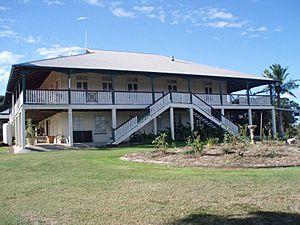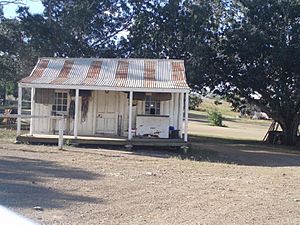Raglan Homestead facts for kids
Quick facts for kids Raglan Homestead |
|
|---|---|

Raglan Homestead, 2009
|
|
| Location | Raglan Station Road, Raglan, Gladstone Region, Queensland, Australia |
| Design period | 1840s - 1860s (mid-19th century) |
| Built | c. 1857 - 1913 |
| Official name: Raglan Homestead, Raglan Station Road | |
| Type | state heritage (archaeological, landscape, built) |
| Designated | 21 October 1992 |
| Reference no. | 600389 |
| Significant period | 1850s-1870s (historical) 1850s-1910s (fabric) |
| Significant components | out building/s, residential accommodation - main house, stables, shed/s, views from, hut/shack |
| Lua error in Module:Location_map at line 420: attempt to index field 'wikibase' (a nil value). | |
Raglan Homestead is a historic property in Raglan, Australia. It's a special kind of farm building called a homestead, which includes the main house and other buildings. People started building it around 1857, and it was finished in 1913. It's also known as Raglan Station. This place is so important that it was added to the Queensland Heritage Register on October 21, 1992.
A Look Back in Time
Raglan Station is located near Larcom Vale Creek, between the towns of Gladstone and Rockhampton. It was started in 1857 by James Landsborough. The main house you see today was built in 1913. However, there are older buildings on the property, like a simple slab hut that might be from when the station first began, and a timber cottage built around 1886.
Early Explorers and Settlers
In 1853, explorers Charles and William Archer explored this area. Later, in 1856, William Landsborough also explored here. The area became part of the Port Curtis Pastoral District in 1854. This district was named after Lord Raglan, a British hero.
When settlers, called squatters, moved into the area, there were conflicts with the Aboriginal people. For example, in 1855, five people at Mount Larcom Station were killed.
The Landsborough Family Arrives
The Landsborough brothers, James and John, came from Scotland. They had been raising sheep in New South Wales. In the 1850s, they looked for better land further north. James Landsborough brought sheep to the Raglan area in 1857. He started building the first slab hut at the Raglan Homestead site.
By 1859, Raglan Station was ready to send its first wool. A mail service also started, connecting Gladstone and Rockhampton through Raglan Station.
Growing the Station
In 1860, James and John Landsborough officially leased the Raglan land. Around this time, James, who had a family, built a new house at Raglan. It was a timber building with two rooms and a wide verandah, plus a separate kitchen.
By 1862, James owned Raglan and nearby Larcom Vale. His Raglan Station grew to include several other areas, covering about 520 square kilometers. He continued to raise sheep, often with the help of Chinese immigrants.
New Owners and Changes
In 1865, James Landsborough left Raglan. Over the next few years, the station had different owners. By 1868, the Bank of New South Wales owned the Raglan leases. They sold part of the land to brothers Thomas and George Creed, who started their own cattle station called Langmorn.
Around 1874, Archibald Menzies from Melbourne bought Raglan. At this time, the homestead had many buildings, including the main house, a store, kitchen, men's hut (possibly the original 1857 hut), and sheep yards. From 1878 to 1885, John A Menzies managed Raglan. He even built a small school at the homestead for his children.
In 1885, Thomas McKellar became the owner. Around 1886, he added a two-room cottage to the 1860 house. Later, his brother Ernest Edward McKellar took over.
The Macdonald Family Era
After a big drought in 1902, Ernest McKellar decided to sell Raglan Station. In 1910, John Murray Macdonald bought it. John and his wife Harriet, also known as Hettie, moved to Raglan in May 1912.
In 1913, the Macdonalds built a brand new, large house at Raglan Homestead. It was designed by architect Fredrick Eckersley Boddington and built by Taylor and McKenzie. They even set up a sawmill nearby to cut the timber for the house.
The new house was built high on timber stumps. It had a wide verandah all around, which was great for enjoying the views. Inside, it had two large living areas, including a dining room with a fireplace and a big tropical lounge. The rooms had high ceilings to keep them cool and French doors that opened onto the verandahs.
Around 1930, the older 1860 house was taken down. After Hettie passed away in 1938, John Macdonald, who had no children, left most of Raglan Station to the Presbyterian Church of New South Wales. This money was used to build homes for older people.
Recent Times
In 1961, the Presbyterian Church sold Raglan Station to John's nephew, Hector McDonald, and his family. Hector's son, Ian, and his family lived there. In the 1970s, Ian made some changes, like moving the old slab hut to be used as a saddle shed near the horse yard.
In 1983, the McDonald family sold Raglan Station. The Olive family bought it in 1986. In 2000, a big storm damaged the main house's roof and verandah, but they were rebuilt.
What Raglan Homestead Looks Like
Raglan Homestead is located near Raglan Creek and Larcom Vale Creek. It's about halfway between Rockhampton and Gladstone. The property has several old buildings, including:
- A slab hut, which might be from 1857.
- A timber cottage from around 1886.
- The main house, built in 1913.
- Sheds and stables.
The Main House (1913)
The main house is a tall, timber-framed building. Its walls are made of timber boards fitted together vertically. It has French doors with small windows above them (breezeways) and timber-framed windows that slide up and down (sash windows). These open onto the verandah that goes all around the house, offering great views. Inside, many of the original timber walls and ceilings are still there.
The Timber Cottage (around 1886)
Just north of the main house is a lower timber cottage. It's covered with weatherboards and has a stepped verandah and a hipped roof made of corrugated iron. It used to have two fireplaces, but the chimney is gone now.
The Slab Hut (possibly 1857)
The slab hut is a single-story timber building with a pointed roof (gable roof) made of corrugated iron. It has a timber floor and walls made of vertical timber slabs. The top parts of the side walls are covered with corrugated iron. There's a stepped verandah on one side. The hut has two windows and a timber door at the front.
Other Buildings
Near the slab hut, there's a large, two-story shed made with rough timber and covered with corrugated iron. There are also timber-framed stables covered with corrugated iron, with big double timber doors. Attached to the stables are another timber shed and timber yards for animals.
Why Raglan Homestead is Special
Raglan Homestead is listed on the Queensland Heritage Register because it's important for several reasons:
Shows Queensland's History
Raglan Homestead helps us understand how Queensland developed. It shows how early European settlers explored and set up large farms (pastoral properties) before towns and agriculture grew. Because it has been used continuously for so long, it's a great example of how the farming industry grew in Queensland.
Helps Us Learn About the Past
This homestead is old and still mostly in its original condition. This means it can teach us a lot about how these properties were run in the past. It also shows us the building methods used over many generations, helping us understand Queensland's history better.
A Great Example of a Homestead
Raglan Homestead is a good example of what a 19th-century homestead looked like. It includes the main house, other important buildings like sheds and stables, fences, and old trees. All these parts together show the main features of a historic homestead.
Beautiful and Important
The buildings at Raglan Homestead are well-designed and well-made. They look nice and use traditional materials. The old trees around the homestead also make the place beautiful and help it stand out in the area.
Connected to Important People
Raglan Homestead has a special connection to the Macdonald family. They were early farmers in the area and helped it grow and develop.


